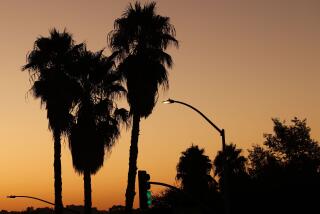Northeast Cooks Under Record Heat
- Share via
WASHINGTON — The Big Apple and Baltimore baked and Washington wilted through the second day of a late spring heat wave Tuesday that broke temperature records and triggered air pollution warnings in cities across the northeastern United States.
The National Weather Service said records for June 8 were shattered in Washington (98 degrees), Baltimore (97 degrees) and the Raleigh-Durham area of North Carolina (96 degrees). New York matched its 97-degree record for the date.
Yeshu Woldemichael, who sells drinks and snacks at a stand in downtown Washington, said: “I drank all of my profit today.”
Even in usually temperate New Hampshire, air conditioners were sold out. A Sears in Concord, N.H., ran out, and customers stood in the aisles waiting for the next truck delivery until they were told it was delayed.
With nearly two weeks to go before the official start of summer, many cities issued warnings about air quality because of the heat and the buildup of ozone.
Thousands Sent Home From School, Work
Thousands of New England government workers and hundreds of schoolchildren in Maryland and Virginia were sent home early because of insufficient air conditioning, while tens of millions of Americans from Chicago to Maine and North Carolina were advised to remain indoors, wear loose-fitting clothing and drink plenty of nonalcoholic fluids.
In response to unexpected demand, New England electric companies warned of possible cuts in power across the region.
Officials in the nation’s capital invited sweltering residents into government buildings and shelters with central air conditioning, and opened fire hydrants at 10 public housing projects and three other sites.
Pittsburgh-area health officials, anticipating more heat and high humidity, issued a heat alert for the rest of the week, said health department spokesman Guillermo Cole.
La Nina, the cyclical weather phenomenon caused by unusually cool temperatures in the Pacific Ocean, is responsible for this week’s heat in the eastern United States, said officials of the National Oceanic and Atmospheric Administration.
La Nina has caused an expansive area of high pressure to sit above northern states much earlier in the year than usual.
Cooler Weather Due Next Week
NOAA officials said rain showers and cooler temperatures are expected to bring relief to most of the northeastern United States by early next week, and normal summer temperatures and rainfall are expected through September.
Still, lacking a series of major storms, the two-year drought in the mid-Atlantic region is expected to extend throughout the year, NOAA officials added.
La Nina is expected to generate one of the most severe U.S. tropical storm and hurricane seasons this summer and fall. But those storms may come too late to save crops in Maryland, Virginia, North Carolina, South Carolina and Georgia, said Doug LeCompte, an NOAA senior meteorologist.
An example of the weather extremes expected by NOAA forecasters this summer can be found in Florida. Earlier this spring, drought sparked hundreds of wildfires across the state, including one that burned more than 150,000 acres of the Everglades northwest of Miami.
But this week about nine inches of rain fell over some neighborhoods in south Florida, leaving many homes flooded, according to local news reports.
At the same time, Californians are trying to warm themselves through one of the state’s coolest and wettest springs in decades.
For example, northern California on Tuesday remained unseasonably cool, with temperatures in downtown Oakland falling to 49 degrees, matching a record set in 1976.
More to Read
Sign up for Essential California
The most important California stories and recommendations in your inbox every morning.
You may occasionally receive promotional content from the Los Angeles Times.










